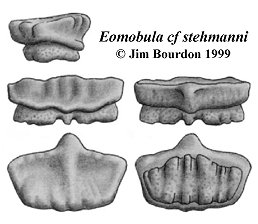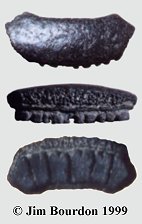|
Herman et al (1989) erected the genus Eomobula for small batoid teeth recovered from Ypresian
sediments of Belgium. Despite my listing of the family as "uncertain", the authors assigned the new
genus to Mobulidae as its name might suggest. A single species, stehmanni, was
described at that time.
The authors characterized these teeth as being similar to those of Mobula (no species given)
females with a broad & massive crown which is subquadrate in profile. The lingual face is
described as having strong irregular protuberances. They note a deep depression in the lower
labial face and that the lingual margin of the crown extends well beyond the root. The root is
described as sub- or pseudo-polyaulacorhizous and being low and flat. Foramina are present
on the labial and lingual root faces below the crown.
A single tooth (Fig. 1) from Potapaco Bed "A" compares well with the Herman et al illustration
which they termed antero-lateral. The patterns present on the occlusal crown face of the Nanjemoy
specimen are not noted by Herman et al, but may simply be functional wear.
Figure 2 illustrates a more common design recovered from Potapaco Beds A & B. Teeth of this
design have been found with both concave and convex occlusal surfaces. A paleontologist,
familiar with the Egem fauna, advised that teeth of this design are referred to as Eomobula
in Europe. Herman et al deemed teeth of this shape to be laterals.
Whereas the antero-laterals didn't look mobulid to this author, it was the laterals that raised the
discomfort level sufficiently to deem their familial placement as uncertain. Except for the
opening/closing of the inter-lobe grooves, the laterals bear the hallmarks of a rhinopterid
tooth design.
 |
 |
Fig. 1 (left) - Eomobula cf stehmanni [1.1 x 2.9 x 2.0 mm]
From the collection of Ron Keil
Fig. 2 (right) - ?Eomobula [2.0 x 6.5 x 2.5 mm]
Nanjemoy Formation (Ypresian), Virginia |
|